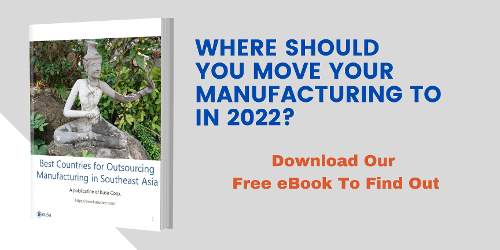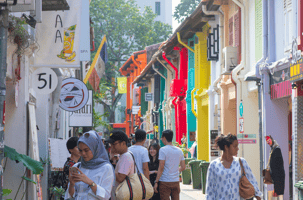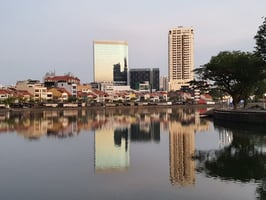Every year, Singaporeans celebrate the 9th of August, also known as “Singapore National Day,” in...
Are Cambodia And Laos The New ASEAN Manufacturing Hubs?
The US-China Trade War and the COVID-19 pandemic have made it abundantly clear to many that diversifying supply chains is vital.
Southeast Asia has become an increasingly attractive destination for companies that want to diversify. Singapore, Thailand, and Vietnam are among the most popular destinations. However, Cambodia and Laos have become promising manufacturing alternatives.
In this week’s article, we will be exploring why Cambodia and Laos’ economic growth, political stability, labour force growth, manufacturing infrastructure, and logistics capabilities make them promising manufacturing alternatives.
Cambodia
-1.png?width=600&name=Untitled%20design%20(4)-1.png)
According to the US International Trade Administration, the Cambodian economy has rapidly and steadily grown over the past decade. Its GDP has consistently grown at an annual rate of 7% and will likely continue to grow at this rate. The manufacturing sector, more specifically the export-oriented garment industry, has been a driver of economic growth (Reuters values the industry at USD 7 billion). Nikkei reports the industry has even been able to weather the pandemic relatively well.
“[The] garment industry continues to drive the Cambodian economy through human capital development, employment generation and foreign direct investment (FDI). Currently, the industry employs over 600,000 people, making the sector the biggest employer in the country,” writes ASEAN Briefing. Its monthly minimum wage (USD 153) is less than neighbours Thailand (USD 250) and Vietnam (USD 166), making it incredibly competitive worldwide.
Moreover, according to PR Newswire, products can be exported to countries such as the US, EU, and Japan with “generalized system of preference” and “most favored nations” treatment. Additionally, the US offers looser quotas and cuts raised import tariffs. That said, the Cambodian Government recognises the need to diversify its manufacturing sector. VOA reports it will shift its manufacturing sector to produce more sophisticated products such as electronics and auto-parts.
To support this shift and enhance connectivity with regional manufacturers, the Government has set up several special economic zones to attract foreign investors. As a result, many Japanese companies have begun setting up shop in these special economics zones. The Government also has plans to improve infrastructure, including the creation of a new roadway connecting the Vietnamese border to Phnom Penh to the Thai border and upgrades to its largest port in Preah Sihanouk.
Admittedly, Cambodian economic growth continues to face hurdles. The EU reinstated tariffs and removed duty-free access in response to greater political crackdowns and alleged human rights abuses, writes Reuters. Furthermore, it continues to face logistical issues. It ranks 98th on the 2018 Logistics Performance Index, scoring particularly poorly in terms of infrastructure but scoring relatively well in terms of “timeliness” and “international shipments.”
Laos
-1.png?width=600&name=Untitled%20design%20(3)-1.png)
According to the ASEAN Post, Laos’ economy has grown six-fold following economic reforms in the 1990s. Its annual GDP growth also hovers between 6%-7% and its inflation rate following the 2008 Global Financial Crisis has remained relatively stable at approximately 1%-2%. Consequently, “[The] country is… fast becoming a manufacturing powerhouse for the region. In a recent report by the World Bank, Lao PDR was identified as an integral link within the regional value chain…”
The manufacturing sector contributed 0.9 percentage points to its overall GDP growth in 2017, with manufacturing exports growing three-fold from USD 270 million in 2013 to USD 780 million in 2017. In real terms, the manufacturing sector grows by 7% annually. Electronics and telecommunications equipment produced in special economic zones have been especially important, though it still lags behind Laos’ main manufactured goods.
These include food and beverage processing and electronic parts and components which account for half of manufactured exports. To support exports, “Laos has… established trade and economic networks by participating in regional integration agreements and free trade agreements… Laos has [also] embraced technology in trade facilitation. To increase customs efficiency, Laos has established the Automated System for Customs Data… at 24 of its border posts,” writes the East Asia Forum.
Embedding itself in global and regional trade networks is important as a land-locked country. Consequently, it has also sought to improve existing infrastructure. It opened a high-speed rail line connecting Kunming to Vientiane, according to the Economist. Development of the Boten-Vientiane high speed rail and the Vientiane–Vangvieng stretch of the China–Laos highway has also begun, according to the East Asia Forum.
However, it still ranks quite low (82nd) on the 2018 Logistics Performance Index. Government projects, investments have been greatly supported by a stable political environment. In 2021, it had a peaceful change of administration, though the country remains a one-party state. The US Department of State states the possibility of political violence targeted at foreign business entities is low. Overall political instability has very rarely occurred making it an attractive destination for foreign investment.
What It Means For Your Business
Economic growth, political stability, labour force growth, manufacturing infrastructure, and improved logistics capabilities make Cambodia and Laos promising alternatives for companies that want to diversify supply chains away from China.
In fact, these reasons make Southeast Asia as a whole promising destinations for companies that want to diversify supply chains away from China. Ultimately, when it comes to relocating or outsourcing manufacturing to Southeast Asia, each economy offers their own opportunities.
-1.jpg?width=146&height=50&name=Kusu%20(1)-1.jpg)



